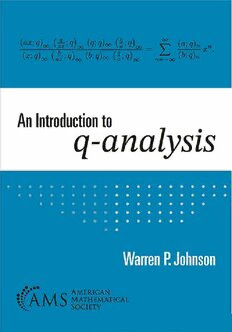Table Of ContentAn Introduction to
q-analysis
An Introduction to
q-analysis
Warren P. Johnson
2010 Mathematics Subject Classification. Primary 05A30, 05A17, 11P84,11P81, 33D15.
For additional informationand updates on this book, visit
www.ams.org/bookpages/mbk-134
Library of Congress Cataloging-in-Publication Data
Names: Johnson,WarrenPierstorff,1960-author.
Title: Introductiontoq-analysis/WarrenP.Johnson.
Description: Providence: AmericanMathematicalSociety,2020. |Includesbibliographicalrefer-
encesandindex. |Summary:
Identifiers: LCCN2020021142|ISBN9781470456238(paperback)|ISBN9781470462109(ebook)
Subjects: LCSH:Combinatorialanalysis. |Graphtheory. |Numbertheory. |AMS:Combinatorics
–Enumerative combinatorics–q-calculus andrelatedtopics. |Combinatorics–Enumerative
combinatorics–Partitionsofintegers. |Numbertheory–Additivenumbertheory;partitions–
Partitionidentities;identitiesofRogers-Ramanujantype. |Numbertheory–Additivenumber
theory;partitions–Elementarytheoryofpartitions. |Specialfunctions.
Classification: LCCQA164.J542020—DDC511/.6–dc23
LCrecordavailableathttps://lccn.loc.gov/2020021142
Copying and reprinting. Individual readersofthispublication,andnonprofit librariesacting
for them, are permitted to make fair use of the material, such as to copy select pages for use
in teaching or research. Permission is granted to quote brief passages from this publication in
reviews,providedthecustomaryacknowledgmentofthesourceisgiven.
Republication,systematiccopying,ormultiplereproductionofanymaterialinthispublication
ispermittedonlyunderlicensefromtheAmericanMathematicalSociety. Requestsforpermission
toreuseportionsofAMSpublicationcontentarehandledbytheCopyrightClearanceCenter. For
moreinformation,pleasevisitwww.ams.org/publications/pubpermissions.
Sendrequestsfortranslationrightsandlicensedreprintstoreprint-permission@ams.org.
(cid:2)c 2020bytheAmericanMathematicalSociety. Allrightsreserved.
TheAmericanMathematicalSocietyretainsallrights
exceptthosegrantedtotheUnitedStatesGovernment.
PrintedintheUnitedStatesofAmerica.
(cid:2)∞ Thepaperusedinthisbookisacid-freeandfallswithintheguidelines
establishedtoensurepermanenceanddurability.
VisittheAMShomepageathttps://www.ams.org/
10987654321 252423222120
Contents
An Introduction to q-analysis xi
Chapter 1. Inversions 1
1.1. Stern’s problem 1
Exercises 5
1.2. The q-factorial 7
Exercises 11
1.3. q-binomial coefficients 14
Exercises 19
1.4. Some identities for q-binomial coefficients 20
Exercises 23
1.5. Another property of q-binomial coefficients 25
Exercises 27
1.6. q-multinomial coefficients 29
Exercises 31
1.7. The Z-identity 33
Exercises 36
1.8. Bibliographical Notes 37
Chapter 2. q-binomial Theorems 39
2.1. A noncommutative q-binomial Theorem 39
Exercises 43
2.2. Potter’s proof 45
Exercises 47
2.3. Rothe’s q-binomial theorem 49
Exercises 53
2.4. The q-derivative 57
Exercises 59
2.5. Two q-binomial theorems of Gauss 61
Exercises 66
2.6. Jacobi’s q-binomial theorem 71
Exercises 72
2.7. MacMahon’s q-binomial theorem 74
Exercises 77
2.8. A partial fraction decomposition 79
Exercises 82
2.9. A curious q-identity of Euler, and some extensions 82
Exercises 86
2.10. The Chen–Chu–Gu identity 88
Exercises 91
v
vi CONTENTS
2.11. Bibliographical Notes 91
Chapter 3. Partitions I: Elementary Theory 93
3.1. Partitions with distinct parts 93
Exercises 95
3.2. Partitions with repeated parts 98
Exercises 103
3.3. Ferrers diagrams 106
Exercises 113
3.4. q-binomial coefficients and partitions 116
Exercises 119
3.5. An identity of Euler, and its “finite” form 120
Exercises 126
3.6. Another identity of Euler, and its finite form 128
Exercises 130
3.7. The Cauchy/Crelle q-binomial series 132
Exercises 137
3.8. q-exponential functions 141
Exercises 145
3.9. Bibliographical Notes 148
Chapter 4. Partitions II: Geometric Theory 149
4.1. Euler’s pentagonal number theorem 149
Exercises 153
4.2. Durfee squares 157
Exercises 162
4.3. Euler’s pentagonal number theorem: Franklin’s proof 164
Exercises 167
4.4. Divisor sums 167
Exercises 173
4.5. Sylvester’s fishhook bijection 180
Exercises 187
4.6. Bibliographical Notes 188
Chapter 5. More q-identities: Jacobi, Gauss, and Heine 191
5.1. Jacobi’s triple product 191
Exercises 195
5.2. Other proofs and related results 201
Exercises 205
5.3. The quintuple product identity 214
Exercises 218
5.4. Lebesgue’s identity 221
Exercises 223
5.5. Basic hypergeometric series 227
Exercises 230
5.6. More φ identities 233
2 1
Exercises 236
5.7. The q-Pfaff–Saalschu¨tz identity 239
Exercises 241
CONTENTS vii
5.8. Bibliographical Notes 243
Chapter 6. Ramanujan’s ψ Summation Formula 247
1 1
6.1. Ramanujan’s formula 247
Exercises 249
6.2. Four proofs 250
Exercises 253
6.3. From the q-Pfaff–Saalschu¨tz sum to Ramanujan’s ψ summation 256
1 1
Exercises 259
6.4. Another identity of Cauchy, and its finite form 259
Exercises 260
6.5. Cauchy’s “mistaken identity” 263
Exercises 265
6.6. Ramanujan’s formula again 266
Exercises 268
6.7. Bibliographical Notes 268
Chapter 7. Sums of Squares 271
7.1. Cauchy’s formula 271
Exercises 272
7.2. Sums of two squares 276
Exercises 278
7.3. Sums of four squares 281
Exercises 286
7.4. Bibliographical Notes 288
Chapter 8. Ramanujan’s Congruences 289
8.1. Ramanujan’s congruences 289
Exercises 291
8.2. Ramanujan’s “most beautiful” identity 292
Exercises 298
8.3. Ramanujan’s congruences again 300
8.4. Bibliographical Notes 303
Chapter 9. Some Combinatorial Results 305
9.1. Revisiting the q-factorial 305
Exercises 309
9.2. Revisiting the q-binomial coefficients 311
Exercises 314
9.3. Foata’s bijection for q-multinomial coefficients 316
Exercises 319
9.4. MacMahon’s proof 319
Exercises 321
9.5. q-derangement numbers 323
Exercises 329
9.6. q-Eulerian numbers and polynomials 331
Exercises 338
9.7. q-trigonometric functions 338
Exercises 342
9.8. Combinatorics of q-tangents and secants 343
viii CONTENTS
9.9. Bibliographical Notes 349
Chapter 10. The Rogers–Ramanujan Identities I: Schur 351
10.1. Schur’s extension of Franklin’s argument 351
Exercises 356
10.2. The Bressoud–Chapman proof 357
Exercises 361
10.3. The AKP and GIS identities 363
10.4. Schur’s second partition theorem 365
Exercises 370
10.5. Bibliographical Notes 375
Chapter 11. The Rogers–Ramanujan Identities II: Rogers 377
11.1. Ramanujan’s proof 377
Exercises 381
11.2. The Rogers–Ramanujan identities and partitions 383
Exercises 388
11.3. Rogers’s second proof 388
Exercises 391
11.4. More identities of Rogers 394
Exercises 399
11.5. Rogers’s identities and partitions 399
11.6. The G¨ollnitz–Gordon identities 403
Exercises 407
11.7. The G¨ollnitz–Gordon identities and partitions 412
Exercises 414
11.8. Bibliographical Notes 416
Chapter 12. The Rogers–Selberg Function 417
12.1. The Rogers–Selberg function 417
Exercises 419
12.2. Some applications 420
Exercises 423
12.3. The Selberg coefficients 423
Exercises 427
12.4. The case k =3 427
12.5. Explicit formulas for the Q functions 429
Exercises 430
12.6. Explicit formulas for S (x) 430
3,i
Exercises 431
12.7. The payoff for k =3 432
Exercises 434
12.8. Gordon’s theorem 434
12.9. Bibliographical Notes 436
Chapter 13. Bailey’s ψ Sum 437
6 6
13.1. Bailey’s formula 437
Exercises 439
13.2. Another proof of Ramanujan’s “most beautiful” identity 442
13.3. Sums of eight squares and of eight triangular numbers 444
CONTENTS ix
Exercises 447
13.4. Bailey’s ψ summation formula 449
6 6
Exercises 450
13.5. Askey’s proof: Phase 1 454
Exercises 457
13.6. Askey’s proof: Phase 2 457
Exercises 460
13.7. Askey’s proof: Phase 3 460
Exercises 461
13.8. An integral 465
Exercises 470
13.9. Bailey’s lemma 471
13.10. Watson’s transformation 475
Exercises 479
13.11. Bibliographical Notes 481
Appendix A. A Brief Guide to Notation 483
Appendix B. Infinite Products 487
Exercises 491
Appendix C. Tannery’s Theorem 495
Bibliography 501
Index of Names 513
Index of Topics 517

